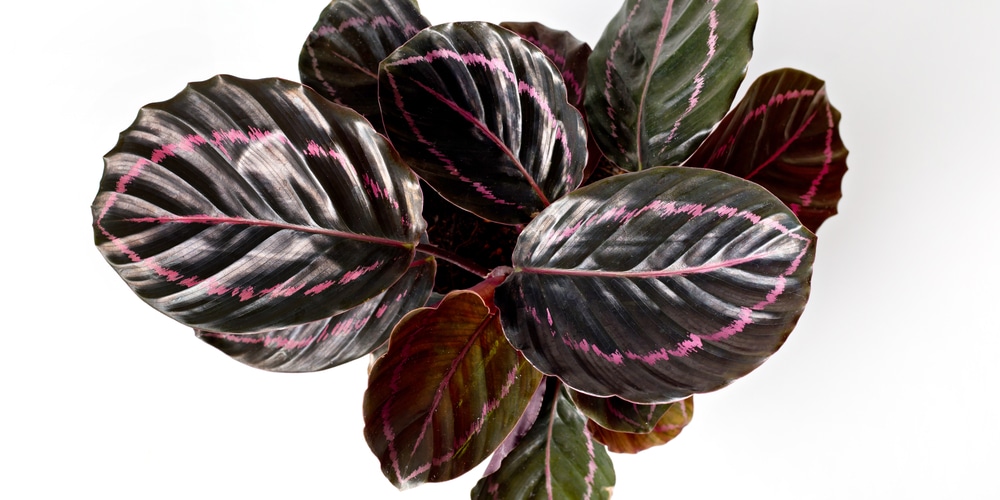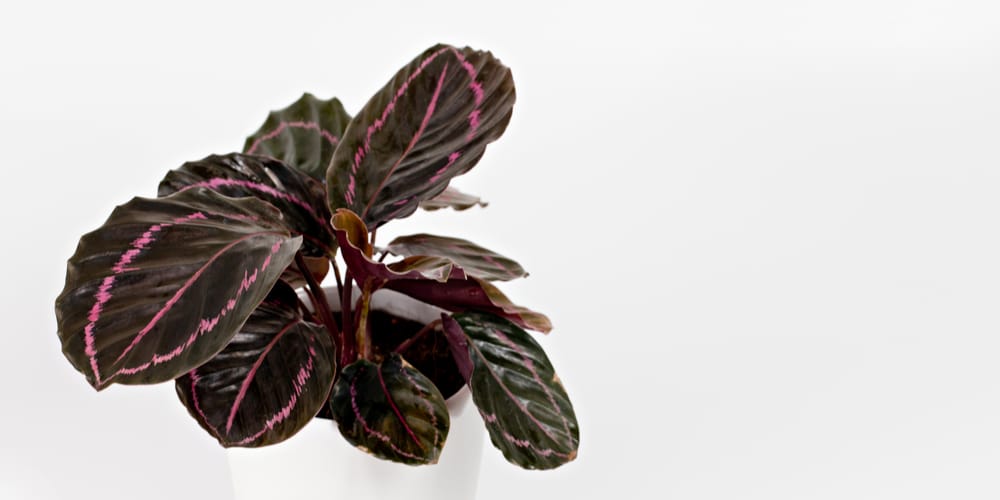The prayer plant, also known as the Calathea Dottie, is a beautiful houseplant that is native to Brazil. Known for its striking foliage, the prayer plant is a popular houseplant that screams tropical vibes.
The Calathea Dottie is a relatively easy plant to care for, as long as you can provide it with the right environment.

| Botanical Name | Calathea Roseopicta |
| Common Name | Calathea Dottie, Prayer Plant |
| Plant Type | Perennial |
| Flower Color | Small and white flowers, rarely flower indoors |
| Size When Mature | 6 – 12 inches tall and wide |
| Bloom Time | Summer |
| Sun Requirements | Indirect sunlight, partial sun |
| USDA Hardiness Zones | 10 – 12 |
| Soil PH Range | 6.0 – 6.5 |
| Soil Type | Moist, well-draining, slightly acidic |
| Water Needs | Medium |
| Native Area | Brazil |
What You Need to Know About Calathea Dottie
Prized for their beautiful, ornate leaves, Calatheas are popular houseplants that add a touch of the tropics to any indoor space. The Calathea Dottie is no exception. This plant gets its name from its dark green leaves which are dotted with white and pink spots.
The underside of the leaves is a deep purple color. This adds to the plant’s uniqueness and makes it a real standout in any indoor jungle.
In its natural habitat, the Calathea Dottie is an understory plant. This means that it grows beneath the canopy of taller trees in the rainforest. As a result, it is used to being in shady, humid conditions.
It is a photonastic plant, meaning that the leaves will open and close in response to light. If the plant is not getting enough light, the leaves will remain closed. This is one of the reasons why their leaves fold up at night, thus the nickname “prayer plant.”
The Calathea Dottie is a low-maintenance plant that can thrive in both bright and low light conditions. However, it does need higher humidity levels to prevent the leaves from browning and curling. One way to increase humidity around your Calathea Dottie is to mist the leaves regularly or place the plant on a pebble tray.
Although Calatheas bloom in their natural habitat, they rarely do indoors. When they do, their flowers are small, white, and insignificant in comparison to their beautiful leaves.
How to Care for Calathea Dottie
Keeping Calathea dottie happy is not difficult, but there are a few things you should know to ensure they grow healthy. Here’s everything you need to know about growing and caring for a thriving Calathea Dottie:
Light
Their elongated, variegated leaves make the Calathea Dottie a real standout in any indoor space. But to keep your plant looking its best, you need to provide it with the right amount of light.
The Calathea Dottie does best in bright, indirect light. However, it can also tolerate low light conditions and will do fine in a north-facing window. If the leaves start to brown or curl, this is a sign that the plant is not getting enough light.
Beware not to place your Calathea Dottie in direct sunlight. Unfiltered sunlight can scorch the leaves and cause them to turn brown. Otherwise, feel free to move your plant around until you find the perfect spot.
During the growing season (spring and summer), you can give your Calathea Dottie a boost by placing it outdoors in a shady spot. Just make sure to bring it back inside before the temperature drops at night.
Water and Soil Needs
The Calathea Dottie is a tropical plant that loves humid conditions. As such, it is important to keep the soil moist at all times but not soggy. The best way to do this is to water your plant when the top inch of soil is dry.
To help retain moisture and humidity, you can add water pebbles or stones to the bottom of your pot. Simply fill the bottom of the pot with pebbles and then water as usual. The water will seep up through the holes and moisten the pebbles.
The Calathea Dottie also benefits from being misted regularly. Just be sure to use distilled water or let the tap water sit out overnight to remove any chlorine before misting.
As for soil, the Calathea Dottie prefers a well-draining, loamy mix. Considering its love for humidity, you may also want to add some organic matter to the soil to help retain moisture. Although it’ll thrive in various soil pH levels, it does and perform its best in slightly acidic soil (between 6.0 and 6.5).
Temperature Requirements
The Calathea Dottie is a tropical plant that originates from the rainforests of Brazil. As such, it prefers warm, humid conditions. Ideally, the temperature for your Calathea Dottie should be between 60°F and 75°F.
During the winter, the temperature can drop a few degrees without harming your plant. However, if the temperature falls below 60°F, this may cause the leaves to start browning and curling.
Additionally, the Calathea Dottie does not do well in drafty conditions. So, if you live in a particularly windy area, you may want to consider placing your plant in a sheltered spot.
It survives in USDA zones 10 to 12, where the temperature rarely falls below 60°F. If you live in a colder climate, you can still enjoy the beauty of the Calathea Dottie by growing it as an indoor houseplant.
Fertilizer
The best fertilizer to use on a Calathea dottie is a balanced, water-soluble fertilizer that is high in nitrogen. Nitrogen is essential for leaf growth, so be sure to use a fertilizer that has a good ratio of nitrogen (N), phosphorus (P), and potassium (K).
It can be applied every two weeks during the growing season, reducing the frequency to once a month during the winter. Always follow the instructions on the fertilizer packaging and dilute it to half-strength before applying it to your plant.
In general, this plant may also do well with less fertilizer than other calatheas. So, it’s best to err on the side of caution and use a weaker solution than what is recommended.
Common Diseases
Because of its love for humidity, the Calathea Dottie is susceptible to a few fungal diseases, such as powdery mildew and botrytis.
Powdery mildew is a white, powdery fungus that appears on the leaves of your plant. If left untreated, it can cause the leaves to turn yellow and eventually die.
Botrytis is a gray mold that affects both the leaves, stems, and flowers of your plant. If left untreated, it can cause the leaves to drop off and the plant to wilt.
Luckily, both of these diseases can be treated with a fungicide. However, prevention is the key to avoiding these diseases in the first place. Prevention includes making sure your plant has good air circulation and is not too close to other plants.
Calathea Dottie Propagation
For those with a green thumb, Calathea Dottie propagation is a fun and rewarding process. With a little patience and the right conditions, it’s easy to grow new plants by division.
First, water your plant thoroughly and then carefully remove it from the pot. Next, use a sharp knife to divide the root ball into 2-3 sections. Make sure each section has several leaves and its own root system. You’ll know when it has its root system when you see small, white roots coming out from the bottom of the pot.
After division, replant each section in its own pot filled with a well-draining, loamy mix. Be sure to water each plant thoroughly and place it in an area with bright, indirect light.
You can also propagate Calathea Dottie by rooting stem cuttings in water. First, take a 4-6 inch cutting from a healthy plant and remove the lower leaves. Next, place the cutting in a jar of water and wait for it to develop roots, which can take anywhere from 2-8 weeks.
Once the roots are about 1 inch long, you can then pot the cutting in a well-draining soil mix. Be sure to water it thoroughly and place it in an area with bright, indirect light.
Related Article: Prayer Plant at Night

